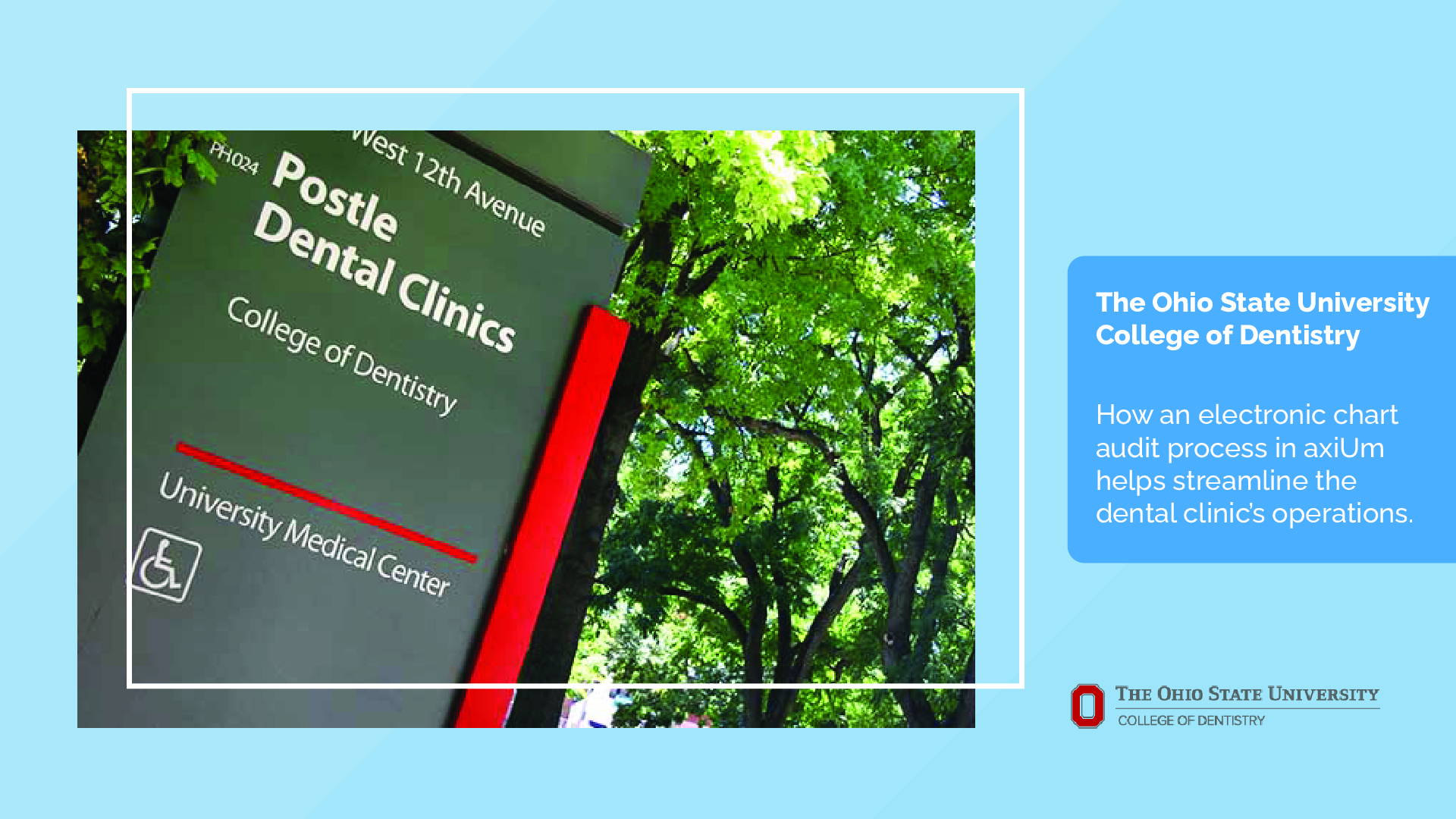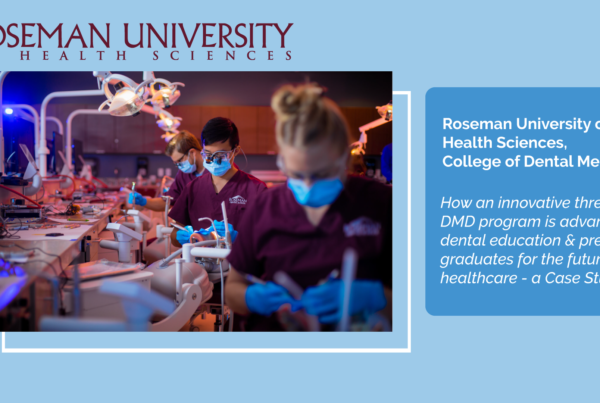Ohio State University, College of Dentistry:
How an electronic chart audit process in axiUm helps streamline the dental clinic’s operations.
Overview
The Ohio State University College of Dentistry is the fourth-largest public dental school in the United States and consists of ten academic divisions representing all major dental specialties. The divisions offer both patient care services and academic programs, allowing dentists to train as specialists.
Educating approximately one hundred students per class, the College of Dentistry provides comprehensive patient care in an unparalleled learning environment with internationally recognized faculty and a supportive network of alumni and friends. In addition, their research programs provide students another dimension beyond classroom and clinical education.
Dedicated to addressing the evolving health care needs of communities in Ohio, the nation, and the world, OSU’s dental college stays true to its vision – improving health by innovation in oral and craniofacial patient care through learning, discovery, and service.
Since 2016 OSU College of Dentistry has been using axiUm to manage its clinical and educational business units. axiUm is the Electronic Health Record (EHR) software of choice for more than 90% of dental academic colleges, universities, and teaching hospitals in North America.
One effective feature OSU’s dental school benefits from is the axiUm Chart Audit report. The report is highly flexible and can be customized many ways, to suit a dental school’s specific workflow, forms, or code set-up. It can be used in a variety of situations, such as (for example) when a patient is leaving the clinic, a provider is leaving the school, or reporting at the end of the school term.
We recently sat down with Henry Fischbach, DDS, Assistant Dean Pre-Doctoral Clinical Operations, Associate Professor-Clinical, Restorative and Prosthetic Dentistry at the Ohio State University College of Dentistry to learn more about the dental school’s chart audit reporting method and how his team successfully evolved from a manual to an electronic process.
The Problem
OSU performs their chart audits twice a year – once in the Spring and again in the Fall. Two areas proved to be challenging for the chart audit team. The first issue was the manual process which was remarkably time-consuming. Often taking weeks to complete, it required the involvement of several staff members. The second was the COVID pandemic, which forced the team to re-think their entire chart audit process to comply with the CDC guidelines of social distancing
Time-Consuming
Before automating their process, the college manually performed chart audits in person. It was a challenging, two-day process that typically required fifteen staff members and faculty to process. It wasn’t always easy for everyone on the team to do the chart audit at the same time. In addition, this required 15 staff or faculty members to be pulled from assignment for two days. Often some students could not be present, which required the team to reschedule the chart audit for these individuals. This would consume a considerable amount of their staff’s time and had an impact on their daily operations.
The chart audit had thirty questions and thirty parameters. A staff or faculty member would sit down individually with each student, and review a minimum of two patient records randomly selected from the EHR. Together they would go through all the questions step-by-step, referring to the patient’s electronic record. If there were deficiencies, they were noted on the grading sheet.
“Some of the parameters were repetitive or they were not in the proper sequence,” said Dr. Fischbach. “For example, we would check if the restorative treatment plan, the medical history, and the notes had been completed by the student. In a separate area, we needed to determine if they had been completed by the faculty or even signed by the patient. Trying to consolidate the data was challenging.”
Once the chart audit had taken place it would often take another week or two to gather all the feedback, tabulate the results, and communicate the results with the students. A separate piece of paper was then generated and given to the student. It outlined the areas within the patient record which required the student to update.
COVID Pandemic
When the COVID pandemic caused many organizations to temporarily close their doors in 2020, Dr. Fischbach’s team at OSU College of Dentistry realized they needed to come up with a new way to effectively perform chart audits.
As their chart audits were historically conducted face-to-face, the college had to re-think their process to remain in compliance with COVID protocols. OSU also wanted to advance from a two-record audit to a full practice review.
“We could no longer do a face-to-face audit, as we did not have enough computers to comply with the social distancing that was required. This made us think about different ways of approaching the chart audit,” remarked Dr. Fischbach.
The Solution
A conversation with the EHR Manager at the University of Pittsburgh’s School of Dental Medicine – Patrick Hetherington – was instrumental in exposing Ohio State University’s College of Dentistry to the axiUm Chart Audit report. Once the team was aware of the feature, it quickly became the logical next step in moving forward. However, shifting from a manual to an electronic chart audit process meant change. It was therefore important they first obtain the approval and support of the clinic directors. Dr. Fischbach’s team began by introducing the new method, allowing the directors a couple of months to test the data. This first step was completed in December 2020.
By January of 2021 they were ready to implement and roll-out the new solution to their dental students. A message went out to the students announcing the implementation of a new full practice electronic chart audit process in axiUm. “We explained that, due to the pandemic, we were no longer able to meet in person to perform the audit the way we used to,” explained Dr. Fischbach. “Also, as it was a brand new process, we initially gave the students additional time to make any corrections.”
Today the chart audit is a student-led initiative. Students check their own records and, when deficiencies are identified, it is their responsibility to correct them. The new method applies to both dental students and dental hygiene students. Although their parameters are different, both groups are audited with the same audit process in axiUm.
Full Practice Audit
The OSU team set a goal to move from a two-record chart audit to a full practice review. Their objective became a reality when they began using the axiUm Chart Audit solution. They went from a partial review of approximately 500 records, to a full audit of more than 6,000 patients.
“At the time, it was obvious to me that we had more problems than what we could identify using a two-record review,” Dr. Fischbach remarked. “Today, axiUm’s chart audit solution allows us to perform a full practice review.”
Increased Productivity
The report has also allowed Dr. Fischbach’s team to gain back some productivity. Gone is the lengthy process and that required fifteen staff members and faculty to process. It now takes a few minutes to generate a report for a student. “It has helped us save time and money, as we no longer “lose” staff members to the old two-day process,” he commented.
The Future
The team at OSU College of Dentistry is looking at other ways to take advantage of the axiUm Chart Audit report. They are considering a new process in which second-year dental students are graded, by using the report to assist third- and fourth-year students with their chart audits. This would remove the burden of responsibility from the clinic directors and apply it as a graded task for the second-year class.
For now, the university’s successful evolution from a manual-based to an electronic-based chart audit process has helped streamline its dental clinical operations, by freeing-up staff time and allowing the school to perform a full practice review.





